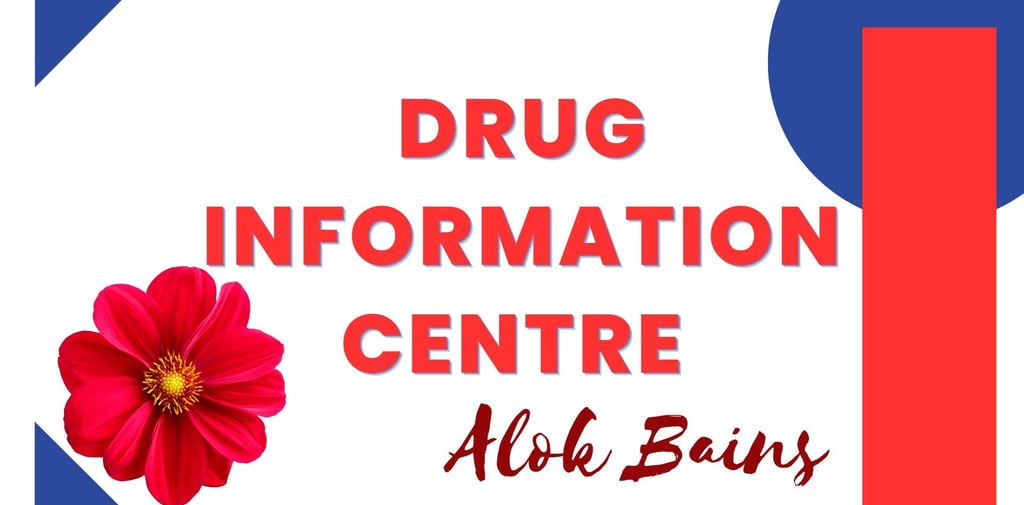Drug Information Centre
Drug Information Centre/Drug Information Service Definition Goal and procedure
HOSPITAL PHARMACY
Alok Bains
5/9/20234 min read


Drug Information Centre (DIC)
Definition, Goal and Procedure
Compiled by Alok Bains
Drug Information Centre (DIC)
The current advancement in the medical sciences generates enormous information about drugs and diseases. Healthcare providers and patients cannot gather all information. Lack of availability of updated information about drugs to health care professionals leads to misuse of the medicines and therapeutic failure. Both misuses of medicines and therapeutic failure are a major burden the healthcare institutions. These can be overcome by establishing Drug Information Centre (DIC).
Clinical pharmacists cope with the vast drug information available, numerous drug formulations and new drugs entering the market. They develop Drug Information Centers to provide accurate timely information to health care professionals and patients. DIC provides updated information for diagnosis, treatment and prevention of diseases. This help to save the time of health care professionals. DIC also fill the gap between medical practitioners and patients on the prescribed medicines.
Drug Information Centre (DIC) is essential to provide pharmaceutical care services effectively and efficiently. The first DIC was established in 1962 in the US to provide comprehensive information to healthcare professionals. World Health Organization (WHO) recognizes DIC as a national program to promote the rational use of medicines and assure quality health care to patients. DIC provides unbiased and organized information to medical practitioners, nurses, pharmacists, other health care professionals, patients and the general public. This drug information may be verbal and/or written/. This improves drug therapy outcome, and minimize drug risk.
Karnataka State Pharmacy Council establishes DIC in 1997. It was the first independent DIC registered with the International Register of drug information services (IRDIS). Some of the independent DIC in India are the CDMU documentation centre, Kolkota, DIC Maharastra State Pharmacy Council, Andhra Pradesh State Pharmacy Council, DIC JSS OOT and Pharma Information Centre Tamilnadu. Some hospitals have also established DIC, DIC NIPPER Mohali. Such as CMC HOSPITAL, PGI Chandigarh, etc.
Drug Information: Current, correct and relevant data on drugs and their uses in a specific situation is drug information.
Drug Information Centre: It is a specialized unit to provide written or verbal authentic, individualized, accurate, relevant and unbiased drug information along with indication, adverse effects, drug toxicity, and drug safety to healthcare providers and patients/consumers. It ensures the safe use of the medicines.
Drug information services: It is specialized services provided by pharmacists to enhance the rationalized recommendation of drugs by medical practitioners and to minimize drug-related problems.
DIC Aims/Objectives/Goal:
To improve the drug therapy outcome,
To promote rational use of the drug and minimize drug risks.
To alleviate the global problem of drug misuse.
To assist anyone to provide quick and evidence-based drug information,
To monitor the quality of drug information.
To educate, train and guide trainee pharmacists, the other health science students.
To provide pharmacy health care services throughout the nation.
Classification of DIC
Drug Information Centers are traditionally classified into three different categories. These are
Hospital-based DIC: The hospital-based DIC answers the in-house call, participates in the formulary decision, participates in assisting in Pharmacy and Therapeutic Committee (P & T) committee, participates in drug use evaluation, coordinates adverse drug reaction reporting, publishes newsletters, provides in-service education, look after investigational new drug activity investigation, etc.
Industry base DIC: They collect information about new drug effects, publish them in journals and gather unpublished documents,m Any person can communicate with the industry for drug information.
Community-based DIC: They mainly communicate with patients and the public and provide information to change patient behaviour, improve patient adherence, and provide quality health care by maximizing the drug utility and minimizing drug risk or drug error.
Procedure:
Sources of Information:
DIC gathers information from the following sources:
Primary Source: Primary source of drug information includes unpublished studies of drugs and published literature (Primary literature) in reputed journals, Review articles information is not the primary source of the information.
Secondary Source: Secondary sources of drug information include literature references mentioned in the abstract of the primary literature. , International Pharmaceutical Abstracts, Index Medicus, Excerpta Medica, and the Iowa Drug Information Service (which also includes full-text reprints of articles).
Tertiary Source: Summarized information by the author or editor such as textbooks, reference books, review articles in journals and drug compendia. Essential drug list, treatment guidelines, drug formularies, pharmacopoeia, etc.
Computerized or electronic information systems and verbal information are the other sources of drug information. Drug information centres (DICs) also provide drug information (verbal and/or written) on request from practising physicians, pharmacists and other healthcare professionals, patients or the general public.
Functions of the DIC
Provides information to healthcare professionals, patients and the general public and updates their knowledge,
Develop a system to prevent medication errors, adverse drug events,
Development of educational resources for patients and HCP.
Improve patient outcomes and support community-based healthcare programs.
Education and training to student pharmacists, residents, and other health care professionals.
Maintain evidence of the effectiveness, pharmacoeconomics, and institution-specific factors.
Monitoring and assessing medication safety alerts issued by the FDA, drug manufacturers or any other sources.
Identification and management of the alternative treatment of various diseases.
Participation in free services such as formulary support, database development and training program for clients. Drug information bulletin publication and distribution.
Participation in quality development research program.
Benefits of DIC
Promotes safe and effective uses of the medicines by identifying drug-related problems in the prescription.
Minimize the occurrence of drug-related issues in patients by promoting clinical care practices. Alleviate the worldwide burden on misuse of the drug.
Provides medication use policy and contributes to processing them in resource development.
Reduces time consumption to health care practitioners in reviewing drug information. Increasing pharmacist productivity, improving patient compliance, and patient safety.
Improves drug cost management by reducing medication abuse.
Increases HCP and patient satisfaction.
The enormous increase in the quality of patient care services.
Reduces self-medication and drug interaction.
